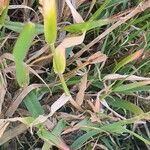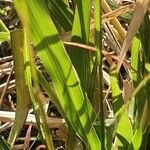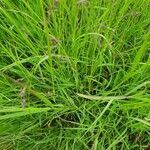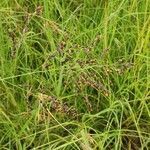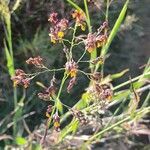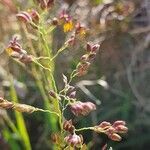Tufted perennial, up to 1 m high; erect, geniculate or occasionally decumbent; lower leaf sheaths glabrous to densely appressed-hairy, bulbous-based hairs present or absent; leaves mainly cauline. Leaf blade up to 300 x 5-10 mm, expanded, rounded or almost cordate at base, green or glaucous, glabrous or loosely to fairly densely hairy with tubercle-based hairs. Inflorescence an open panicle, branches spreading, spikelets distant. Spikelets 2.5-3.0 mm long, dorsiventrally compressed; glumes unequal; lower glume ovate, 1/2-2/3 length of spikelet; upper glume 7(-9)-nerved. Florets 2; lower floret male, lemma 7(-9)-nerved, palea well developed; upper floret bisexual, lemma indurated, smooth, pale to dark, shiny, entire, margins only clasping edges of palea. Flowering time Oct.-May.
Perennial, tufted. Culms erect or ascending from a knotty base, 15–100 cm tall. Leaves basal and cauline; leaf sheaths glabrous, pilose or hispid; ligule 0.5–1 mm, a ciliolate membrane; leaf blades linear, flat, 7–30 × 0.5–1 cm, glabrous or pilose, base straight to amplexicaul, apex acute or acuminate. Panicle ovate in outline, 4–30 cm, much branched; branches ascending or spreading, the spikelets evenly spread or clustered on the branches. Spikelets ovate-elliptic, 2–3 mm, glabrous, acute; lower glume broadly ovate, 1/4–1/3 length of spikelet, 1–3-veined, acute to acuminate; upper glume ovate, as long as spikelet, 7–9-veined, acute; lower floret staminate, lemma similar to upper glume, palea well developed; upper floret pale yellow or brown, smooth, shiny.
Tufted perennial 500-1000 mm high, erect, geniculate or occasionally decumbent; lower leaf sheaths glabrous to densely adpressed-hairy, bulbous-based hairs present or absent; leaves mainly cauline; culm nodes glabrous or if hairy, hairs only in the furrows not ridges, node obvious. Leaf blade to 300 x 5-10 mm, expanded, rounded or almost cordate at base, green or glaucous, glabrous or loosely to fairly densely hairy with tubercle-based hairs. Inflorescence branches spreading; spikelets distant. Spikelet 2.5-3.0 mm long; lower glume ovate, 1/4-1/3 spikelet length; upper glume 7(-9)-nerved; lower floret male, lemma 7(-9)-nerved, palea well developed; upper lemma pale to dark, shiny.
Perennial, tufted (erect, geniculate or occasionally decumbent), up to 1 m high. Leaf blades up to 300 mm long, 5-10 mm wide, lower leaf sheaths glabrous to densely appressed-hairy, bulbous-based hairs present or absent, leaves usually mainly cauline, broad. Spikelets 2.5-3.0 mm long. Inflorescence branches spreading with spikelets distant; lower glume ovate, half to two-thirds the length of spikelet; upper glume and lower lemma 7(-9)-nerved; lower floret male, with palea well developed; female-fertile (upper) lemma pale to dark, shiny.
A grass. It is often bent downwards. The leaves are flat and have long points. The leaf blade is slightly heart shaped at the base. The flowering shoots are narrow but branched. It is erect.
Tufted perennial up to 1·2 m. high
Introduced as a fodder grass.
